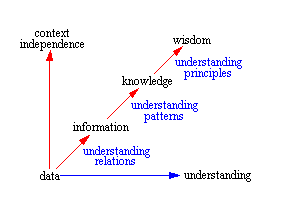How Is Information Technology Changing Organizations?

From its inception, information technology (IT) has been changing the way business is done. IT is changing the basis of business from labor and manual skills to knowledge management. The jobs required by information technology in business, as well as the technology itself, are changing the social system of your organization. Information technology is key to a firm’s competitiveness — organizations that are unable to adapt to the rapid pace of technology change will not survive in the marketplace of the future. Let’s look at how information technology is changing organizations.
How Is Information Technology Changing Business?
The workplace has changed significantly over the last half-century due to information technologies, mainly due to automation of existing processes. Accounting systems are a necessity, while lean and six sigma are driving improvement. What will be the cost of such change and what can be done to prepare for it?
The IT Future
Nobody can predict the future, but there is one major trend developing that will significantly affect the day-to-day operation of your business tomorrow: the shift from a mechanistic view to an information orientation. This change permeates any organization, changing the responsibilities of management, the IT policies and procedures manual, the social system the organization is used to, and the skills you will need to succeed.
The Information Age
Flying and space travel were science fiction a little more than a century ago, foretold by the likes of Jules Verne and H.G. Wells; today, these are commonplace. But ideas like these belong to the scientific age, an age which is coming to an end. A new age — the information age — is in process. In the information age, systems are being devised to increase the productivity of the professional at the expense of unskilled workers. These workers will find their jobs eliminated or transformed into something else altogether.
Information Technology Matures
Information technology is no longer in its infancy, but represents a greater transition phase. In his analysis of social and cultural dynamics, Pitirim Sorokin suggests that this transition phase is a cultural transformation similar to the invention of agriculture or the transition from the middle ages to the scientific age, though even more dramatic, due to the faster rate of change. This accelerated rate of change was discussed by William Conboy as early as the 1960’s. Conboy estimated that the amount of knowledge in existence doubled between 1 AD and 1750. Knowledge doubled again by 1900, 1950, 1960, and Conboy projected it to double again by 1963 and beyond. This doubling has created what is called accelerating returns.
Information is Doubling
It would be difficult to estimate the amount of knowledge and wisdom from information in existence today. It must be staggering to think about and yet it continues at an incredible pace. What this curve represents, in line with what Sorokin suggests as a cultural transformation, is that new paradigms, thoughts and adjustments to change will need to be developed in order to survive in the age of information.
Businesses, like their workers, will find their industries transformed or eliminated by IT. Labor based industries are being displaced by skill based. Skill based industries are being replaced by knowledge based. The result will be to find manual labor industries moving to where the labor is cheap and economies shifting to service based knowledge industries. There is too much happening too fast for us to rely on mechanistic theories of old. New, dynamic or relative theories are needed. The key to management in the future will be in understanding the dynamics of the information age and adapting appropriately.
The Speed of Information
Business will no longer be thought of as operating as usual. A focus will be placed on both the speed at which information can be passed through the organization and the importance of that information. Systems will be developed to increase the rate at which information passes, while the importance of information will become the deciding factor in the marketplace. In order to remain competitive, organizations will need to incorporate more information technology while developing a greater understanding of the importance of information and how it relates to workflow and productivity.
Information Flows
In order for information to be used effectively, it must flow easily through the organization. Information quickly becomes useless or obsolete, so it’s important to act on information quickly and decisively to get its full value. Both computers and communication systems are used to increase the speed and efficiency at which information can be passed. Computers are being used increasingly to connect different departments together and thus automating the passage of the information that they rely upon to do business.
More and more management information systems, policy management software, and computer-aided manufacturing systems are being required to establish and maintain a competitive edge. New communication strategies are being designed around the individual, allowing workers and management to conduct business across many miles, electronically, without ever leaving the office. The advent of email, teleconferencing, and now the paperless office makes this possible. The portability of electronic work at the touch of a button, across the internet, has led to decentralization of offices and the movement of work across country borders.
Importance of Information
John Diebold recognized the importance of information to the organization when stating three of its unique properties:
- The value of information increases as it is used;
- Information is not depleted, but it may become obsolete; and
- It is a basic factor of productive activity, comparable with labor, capitol, energy, and raw materials.
Diebold also stated that one of the problems with management is its belief that automating the office is done mainly as a clerical savings; he felt the emphasis should be on improving the productivity of managers and other professionals. An example of this belief can be seen in automation dollars spent on office workers in 1977, which varied from $2,000- $6,000 per worker while at the same time the average spent on an industrial worker was $25,000.
If businesses are to remain competitive, it is important for management to spend the money required to provide the tools to increase the productivity of all of its workers. This cannot be done, however, until management realizes the important relationship of information technology to worker productivity.
Understanding Information Technology
In order to understand information technology better, Diebold proposed the need for a better methodology relating productivity to automation or rather the concept of the “time value of information.” Accountants and economist have long understood the time value of money and this concept has been used by management to justify decision making. What has happened is that information tools are looked upon as more of an expense then a resource and this attitude needs to change to better utilize information and improve productivity.
Information Technology Facilitates Communication
Information technology has revolutionized our lives and has greatly facilitated communication throughout society, yet the principle barrier that remains will be the understanding of that information flow and the importance it has to the organization. If this understanding can be achieved then the flow will not be impeded. Information technology systems will be used by all to improve the productivity of all and the company will remain competitive.
Social Media Systems
Questions in the information age have been surfacing, causing rifts in the social system of the organization. Changes in thought are occurring as part of the cultural transformation fostered by social media. Work groups are forming as workers move away from linear processing (assembly lines) and toward other remote models of working, yet we are glued to our computer with the explosion of social media. Social interaction as our parents and grandparents knew it is on the decline. Organizations are forced to adopt changes in order to survive in the fast-paced information age.
The mechanistic view of the universe is a relic of the scientific age. It represents society as it was, 100 and more years ago. Now, the thoughts, perceptions, and values that form that vision of reality are changing. The information age has begun and with it, a paradigm shift is underway. This represents a time of great opportunity for entrepreneurs to develop the new views.
History shows us that, as business becomes more expensive to operate the old way, new technologies are incorporated. Our friend John Diebold pointed out that information technology is an instrument of human change that has three stages:
- First, computers do the same job in a different way;
- Second, the job changes; and
- Third, a change in society occurs.
The third change can be seen happening today when hackers break into computers causing alarm over how business can improve cybersecurity. These types of changes are evident in the news and will continue to highlight the role — and the value — of information in society.
A second shift can be seen in the formation of networks and partnerships at the expense of hierarchical and bureaucratic forms of management. Businesses and their supply chains are having to work in unison to maintain a competitive advantage. The assembly line is on the decline and the rise of the work group is the new reality.
The original workforce was a gang — a semi-autonomous group under a gang leader who took responsibility for a piece of work. The advent of machines reshaped the gang around the assembly line of the new machines. Information technology has given workers the tools to form back into groups similar to the original workforce. But, as technology advances and is made available to the individual, these work groups will begin to dwindle to a single person or none at all.
The effect of the work groups shrinking to fewer people will be that individuals will become more autonomous at the expense of social interaction and corporate loyalty. Smaller work groups will have a greater amount of technology about them and thus be able to work remotely. This could mean at home, in a car, plane, or boat. As people work away from the office, they risk losing touch with the people back at the office.
They are unable to socialize as well with the others and, as a result, their loyalty to the organization may decline. In addition, promotions are often based on social interaction; without it, people are at risk of being passed over for promotion. But, with the increase in worker independence comes an increase in job mobility. People will contract out, or outsource, more services. The result is a continued rise in the entrepreneurial workforce, where the individual develops a self-identity outside of the traditional workplace.
Skills Displacement
There is a dramatic social implication that has thus far only been alluded to. As technology changes the organization, automating more tasks, fewer people are required to get the job done. Not only has information technology increased productivity: it has eliminated jobs, as well. If work groups dwindle to one person or none at all, where will the rest of the group go?
There are two answers to this question — job retraining and redefinition. The lower skilled worker’s job is being eliminated by technology, so they will require training in a new job. High-tech professionals will find their field passing them by, so they’ll require retraining in their field. On the other hand, there may not be enough jobs for everyone as more and more robots and technology perform more of the work. This will require people to work less hours, share jobs, retire early, or (in some way) get by with less.
More time will need to be spent on education, not only to keep the workforce educated on the new technology, but also to keep more people busy. Lower skilled and unskilled workers will find their jobs being eliminated and so they will go back to school in order to learn newer skills. New theories and discoveries will continue at a rapid pace which will put pressure on people to keep up with the advances.
Graduate degrees will become the rule rather than the exception. Businesses will put people through school to keep the individual from becoming obsolete and to give them something to do. There will be fewer jobs and the jobs that exist will require more skills than before. Management will need to develop fewer, highly skilled, individuals with workplace training programs and then keep them. This again is a greater people orientation then before.
Remote Working
A redefinition of the workplace, effectiveness of remote working, and the jobs people perform will be required. Today’s factories will go the way of yesterday’s agriculture. As farms were automated and more could be done with fewer people, many left for the city or idled their land. In the last 100-plus years, agrarian jobs fell from 41% of the labor force to under 1%, yet they seem to have been absorbed into the labor force.
Handy proposed one way in which automobile factory work might shift. If fewer cars were made and they were being made by robots then manufacturing jobs would decline. People would need to keep their cars longer and the maintenance activity, which is labor intensive, would increase. This could be picked up by small garages or self-employed mechanics. This would mean that society would need to move to a high quality maintenance concept rather then a lower quality disposable one.
What Handy illustrates is that the solution to the problem of job elimination is based upon the redefinition of business by society. Another concept popularized by many is one where everybody works less, which is already happening in Europe. Shorter work weeks, early retirement, longer vacations, and more time off for schooling. The implication here is that more people are staying employed, but at the expense of a smaller paycheck with more leisure time.
Leisure Time
In an age where leisure time is becoming increasingly important, this notion has caught on at a number of businesses. The problem of child care could decrease if more time were spent at home. More time could be spent on personal, self-actualizing events like meditation to make you more successful. This also points to an increased interest in the “third age of life”, that part of life that is beyond growing up and working.
There are many possibilities that exist with the flexibility that is offered by the jobs of the future. The key question is how society will react to the changes that are occurring in the workplace and what people are willing to allow to take place. One thing is for sure and that is that the changes are inevitable.
There is a cartoon by Charles Adams (from a 1955 issue of “The New Yorker” magazine) that shows two caterpillars and above them, a butterfly emerging from its cocoon and opening its wings. One caterpillar says to the other, “You’ll never get me up in one of those things.” This social commentary still resonates in the 21st century: Change is inevitable.
Dynamics of Information Technology
The rapidly occurring changes force management to discard old, mechanistic views. The key to management in the future will be in understanding the dynamics of information technology, adopting a greater people orientation, and adapting appropriately to the changes. Technology can improve the efficiency of a business. Survival in the future will be based on the effective use of both information and people as resources in order to keep the organization progressing, competitive, and alive. So, is information technology changing your business? If so, how? What are the benefits and costs to your business?

















Hi, Chris Anderson. very helpful blog. lots of information about IT. Thank you for providing this information.